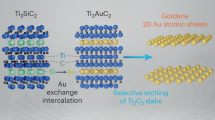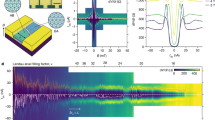Abstract
Electron transport through metal–molecule contacts greatly affects the operation and performance of electronic devices based on organic semiconductors1,2,3,4 and is at the heart of molecular electronics exploiting single-molecule junctions5,6,7,8. Much of our understanding of the charge injection and extraction processes in these systems relies on our knowledge of the potential barrier at the contact. Despite significant experimental and theoretical advances a clear rationale of the contact barrier at the single-molecule level is still missing. Here, we use scanning tunnelling microscopy to probe directly the nanocontact between a single molecule and a metal electrode in unprecedented detail. Our experiments show a significant variation on the submolecular scale. The local barrier modulation across an isolated 4-[trans-2-(pyrid-4-yl-vinyl)] benzoic acid molecule bound to a copper(111) electrode exceeds 1 eV. The giant modulation reflects the interaction between specific molecular groups and the metal and illustrates the critical processes determining the interface potential. Guided by our results, we introduce a new scheme to locally manipulate the potential barrier of the molecular nanocontacts with atomic precision.
This is a preview of subscription content, access via your institution
Access options
Subscribe to this journal
Receive 12 print issues and online access
$259.00 per year
only $21.58 per issue
Buy this article
- Purchase on Springer Link
- Instant access to full article PDF
Prices may be subject to local taxes which are calculated during checkout



Similar content being viewed by others
References
Park, Y. D., Lim, J. A., Lee, H. S. & Cho, K. Interface engineering in organic transistors. Mater. Today 10, 46–54 (2007).
Soubatch, S., Temirov, R. & Tautz, F. S. Fundamental interface properties in OFETs: Bonding, structure and function of molecular adsorbate layers on solid surfaces. Phys. Status Solidi A 205, 511–525 (2008).
Friend, R. H. et al. Electroluminescence in conjugated polymers. Nature 397, 121–128 (1999).
Janata, J. & Josowicz, M. Conducting polymers in electronic chemical sensors. Nature Mater. 2, 19–24 (2002).
Nitzan, A. & Ratner, M. A. Electron transport in molecular wire junctions. Science 300, 1384–1389 (2003).
Xu, B. & Tao, N. J. Measurement of single-molecule resistance by repeated formation of molecular junctions. Science 301, 1221–1223 (2003).
Smit, R. H. M. et al. Measurement of the conductance of a hydrogen molecule. Nature 419, 906–909 (2002).
Reed, M. A., Zhou, C., Muller, C. J., Burgin, T. P. & Tour, J. M. Conductance of a molecular junction. Science 278, 252–254 (1997).
Ishii, H., Sugiyama, K., Ito, E. & Seki, K. Energy level alignment and interfacial electronic structures at organic/metal and organic/organic interfaces. Adv. Mater. 11, 605–625 (1999).
Cahen, D. & Kahn, A. Electron energetics at surfaces and interfaces: Concept and experiments. Adv. Mater. 15, 271–277 (2003).
Duhm, S. et al. Orientation-dependent ionization energies and interface dipoles in ordered molecular assemblies. Nature Mater. 7, 326–332 (2008).
Seitsonen, A. P. et al. Density functional theory analysis of carboxylate-bridged diiron units in two-dimensional metal–organic grids. J. Am. Chem. Soc. 128, 5634–5635 (2006).
Wandelt, K. Thin Metal Films and Gas Chemisorption 280 (Elsevier, 1987).
Bagus, P. S., Staemmler, V. & Wöll, C. Exchangelike effects for closed-shell adsorbates: Interface dipole and work function. Phys. Rev. Lett. 89, 096104 (2002).
Leung, T. C., Kao, C. L., Su, W. S., Feng, Y. J. & Chan, C. T. Relationship between surface dipole, work function and charge transfer: Some exceptions to an established rule. Phys. Rev. B 68, 195408 (2003).
Velic, D., Hotzel, A., Wolf, M. & Ertl, G. Electronic states of the C6H6/Cu(111) system: Energetics, femtosecond dynamics, and adsorption morphology. J. Chem. Phys. 109, 9155–9165 (1998).
De Renzi, V. et al. Metal work-function changes induced by organic adsorbates: A combined experimental and theoretical study. Phys. Rev. Lett. 95, 046804 (2005).
Ploigt, H.-C., Brun, C., Pivetta, M., Patthey, F. & Schneider, W.-D. Local work function changes determined by field emission resonances: NaCl/Ag(100). Phys. Rev. B 76, 195404 (2007).
Dougherty, D. B., Maksymovych, P., Lee, J. & Yates, J. T. Jr Local spectroscopy of image-potential-derived states: From single molecules to monolayers of benzene on Cu(111). Phys. Rev. Lett. 97, 236806 (2006).
Zerweck, U., Loppacher, C., Otto, T., Grafström, S. & Eng, L. M. Accuracy and resolution limits of Kelvin probe force microscopy. Phys. Rev. B 71, 125424 (2005).
Olesen, L. et al. Apparent barrier height in scanning tunneling microscopy revisited. Phys. Rev. Lett. 76, 1485 (1996).
Sotiropoulos, A., Milligan, P. K., Cowie, B. C. C. & Kadodwala, M. A structural study of formate on Cu(111). Surf. Sci. 444, 52–60 (2000).
Johnston, S. M., Rousseau, G., Dhanak, V. & Kododwala, M. The structure of acetate and trifluoroacetate on Cu(111). Surf. Sci. 477, 163–173 (2001).
Lin, N. et al. Two-dimensional adatom gas bestowing dynamic heterogeneity on surfaces. Angew. Chem. Int. Ed. 44, 1488–1491 (2005).
Rusu, P.C., Giovannetti, G., Weijtens, C., Coehoorn, R. & Borcks, G. Work function pinning at metal–organic interfaces. J. Phys. Chem. C 113, 9974–9977 (2009).
Tait, S. L. et al. One-dimensional self-assembled molecular chains on Cu(100): Interplay between surface-assisted coordination chemistry and substrate commensurability. J. Phys. Chem. C 111, 10982–10987 (2007).
Barth, J. V., Costantini, G. & Kern, K. Engineering atomic and molecular nanostructures at surfaces. Nature 437, 671–679 (2005).
Gambardella, P. et al. Supramolecular control of the magnetic anisotropy in two-dimensional high-spin Fe arrays at a metal interface. Nature Mater. 8, 189–193 (2009).
Baroni, S. et al. <http://www.quantum-espresso.org>.
Bengtsson, L. Dipole correction for surface supercell calculations. Phys. Rev. B 59, 12301 (1999).
Acknowledgements
We thank Mario Ruben for synthesizing the PVBA. A.D.V. and G.L. acknowledge funding from EPSRC grant EP/G044864/1 and the ESF-EUROCORES SONS Programme.
Author information
Authors and Affiliations
Contributions
All authors contributed extensively to the work.
Corresponding author
Ethics declarations
Competing interests
The authors declare no competing financial interests.
Supplementary information
Supplementary Information
Supplementary Information (PDF 533 kb)
Rights and permissions
About this article
Cite this article
Vitali, L., Levita, G., Ohmann, R. et al. Portrait of the potential barrier at metal–organic nanocontacts. Nature Mater 9, 320–323 (2010). https://doi.org/10.1038/nmat2625
Received:
Accepted:
Published:
Issue Date:
DOI: https://doi.org/10.1038/nmat2625
This article is cited by
-
Electronic decoupling of polyacenes from the underlying metal substrate by sp3 carbon atoms
Communications Physics (2020)
-
Assessment of Scanning Tunneling Spectroscopy Modes Inspecting Electron Confinement in Surface-Confined Supramolecular Networks
Scientific Reports (2013)
-
Imaging the charge distribution within a single molecule
Nature Nanotechnology (2012)



